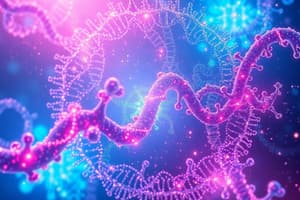Podcast
Questions and Answers
What is the primary purpose of mechanisms in Design and Technology?
What is the primary purpose of mechanisms in Design and Technology?
- To create aesthetic appeal in products
- To increase the cost of products
- To reduce the weight of products
- To create movement, change shape, or perform specific functions (correct)
What type of mechanism converts rotary motion into linear motion?
What type of mechanism converts rotary motion into linear motion?
- Bearings
- Cams and Followers (correct)
- Gears and Transmissions
- Linkages
What is the purpose of bearings in mechanisms?
What is the purpose of bearings in mechanisms?
- To change the direction of motion
- To store energy
- To increase friction between moving parts
- To reduce friction and wear between moving parts (correct)
What is the study of the motion of objects without considering forces known as?
What is the study of the motion of objects without considering forces known as?
What is a key consideration when selecting materials for mechanisms?
What is a key consideration when selecting materials for mechanisms?
What is an example of an application of mechanisms?
What is an example of an application of mechanisms?
Flashcards are hidden until you start studying
Study Notes
Mechanisms in Design and Technology
Mechanisms are used to create movement, change shape, or perform specific functions in products. They can be classified into three main categories:
Types of Mechanisms
- Linkages: Connect two or more components to create movement or rotation.
- Examples: hinges, pivots, and lever systems
- Cams and Followers: Convert rotary motion into linear motion.
- Examples: door handles, gear systems, and printing press mechanisms
- Gears and Transmissions: Change speed, direction, or torque of rotational motion.
- Examples: gearboxes, bicycle gears, and clockwork mechanisms
Key Components of Mechanisms
- Axles: Rotating shafts that support rotating components.
- Bearings: Reduce friction and wear between moving parts.
- Fasteners: Hold components together, such as screws, nuts, and bolts.
- Springs: Store energy and provide resistance to motion.
Mechanism Design Considerations
- Kinematics: Study of the motion of objects without considering forces.
- Dynamics: Study of the motion of objects considering forces and energy.
- Material selection: Choose materials that can withstand stresses, loads, and environmental conditions.
- Manufacturing processes: Consider the feasibility and cost of manufacturing the mechanism.
Applications of Mechanisms
- Robotics: Use mechanisms to create movement and perform tasks.
- Automotive systems: Use mechanisms to transmit power, change direction, and provide movement.
- Medical devices: Use mechanisms to create movement, change shape, or perform specific functions.
- Consumer products: Use mechanisms to create movement, change shape, or perform specific functions in everyday products.
Studying That Suits You
Use AI to generate personalized quizzes and flashcards to suit your learning preferences.




